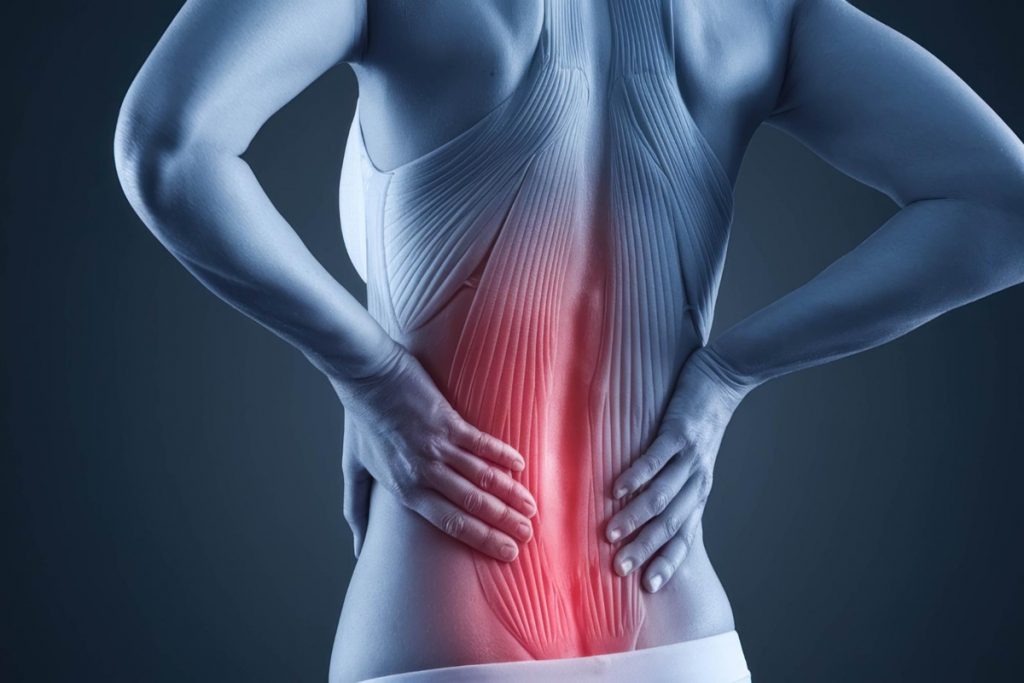Middle back pain when breathing, particularly pain in the middle of the back or even upper middle back pain when breathing, is a common and often distressing experience. This type of pain usually affects the thoracic spine and surrounding muscles, where discomfort can range from mild soreness to sharp, intense pain that may limit movement and breathing. Causes for this condition vary widely and may include muscle strain, rib injuries, disc problems, lung-related issues, or even postural problems that compress the spine. Some cases may also involve underlying health conditions, including circulatory issues, scoliosis, or pulmonary embolism, each of which can contribute to middle back pain when breathing.
In this guide, we’ll explore the common causes, symptoms, and methods for diagnosing, treating, and preventing middle back pain when breathing to help you manage and mitigate this discomfort effectively.
What is Middle Back Pain When Breathing?
The thoracic spine, which starts at the base of the neck and stretches down to the middle of the torso, is the region commonly referred to when discussing “middle back pain.” This area is integral to stabilizing the rib cage and plays a crucial role in breathing movements. Pain along the thoracic spine is particularly impactful, given its location and function in supporting respiratory mechanics and protecting the heart and lungs.
Middle back pain when breathing can manifest as a dull ache or pain in the middle of the back when breathing, often intensified by deep breaths. Located along the thoracic spine, which supports the rib cage, this area is crucial to respiratory movement, making injuries or disorders here particularly impactful. Understanding the thoracic spine’s role and the muscles and ribs involved in breathing can shed light on why middle back pain when breathing is so common and how it affects overall health.
Understanding the Thoracic Spine and Its Role in Breathing
The thoracic spine is comprised of 12 vertebrae situated between the neck and lower back, supporting the rib cage and protecting vital organs like the lungs and heart. While less flexible than other parts of the spine, this region is instrumental in stability and respiratory function. Any dysfunction in the thoracic spine, such as a herniated disc or conditions like scoliosis and kyphosis, can lead to pain that radiates with each breath. When pressure is applied to nerves in the spine, even simple movements like inhaling can result in sharp pain in the middle of the back.
How the Muscles and Ribs Interact with Breathing
Breathing involves the coordination of the rib cage, intercostal muscles, and thoracic spine. These muscles expand and contract with each breath, while the rib cage provides a stable structure that allows for lung expansion. Injuries to the ribs or surrounding soft tissues, such as muscle strain, can disrupt this balance, resulting in middle back pain when breathing. Conditions like pleurisy, inflammation of the pleura (the lining around the lungs), can also affect the interaction between the ribs and spine, intensifying pain with each breath.
Common Causes of Middle Back Pain When Breathing
Middle back pain when breathing can stem from various causes, ranging from simple muscle strain to more serious health conditions. Here are the most common contributors:
Muscle Strain or Tension
One of the most frequent causes of pain in the middle of the back when breathing is muscle strain or tension. Overuse, poor posture, and physical activities that overstretch or compress the muscles in the thoracic region can lead to strained muscles. Muscle tension around the rib cage can result in upper middle back pain when breathing, which often worsens with deeper breaths. Prolonged poor posture can contribute to muscle strain, as it forces the thoracic spine into unnatural positions, leading to chronic discomfort.
Rib Injuries and Fractures
Rib injuries, including fractures and bruises, can result from physical trauma, sports injuries, or sudden impact to the chest wall or clavicles. Since the ribs move with each breath, even minor rib injuries can lead to sharp pain in the middle of the back when breathing, especially with deep inhalation. Fractures or soft tissue injuries near the ribs often require rest and medical attention to heal properly and avoid complications.
Inflammation and Costochondritis
Inflammation can occur around the cartilage that connects the ribs to the sternum, a condition known as costochondritis. This inflammation can cause sharp pain in the chest and mid-back region, often worsening with deep breaths or coughing. Costochondritis is usually caused by physical strain or respiratory infections and can be misdiagnosed as heart conditions or pleurisy.
Spinal Conditions (Herniated Disc, Scoliosis)
Spinal conditions, including herniated discs, scoliosis, and kyphosis, are significant contributors to middle back pain when breathing. A herniated disc in the thoracic spine may press on nerves that influence respiratory muscles, causing discomfort. Similarly, spinal curvature disorders such as scoliosis can lead to uneven pressure on the thoracic spine and rib cage, increasing the risk of pain when breathing.
Lung-Related Causes (Pleural Effusion, Pulmonary Embolism)
In some cases, lung-related issues like pleural effusion (fluid buildup around the lungs) or a pulmonary embolism (blood clot in the lungs) may cause pain in the middle of the back. These conditions are often accompanied by breathing difficulties and may present as sharp pain in the middle of the back when breathing, requiring immediate medical attention. Conditions like pneumonia and lung tumors may also cause mid-back pain, and persistent pain could be a warning sign of severe lung issues.
Poor Posture and Sedentary Lifestyle
Poor posture or extended periods of sitting can strain the thoracic spine, leading to musculoskeletal-related back pain. Slouching or improper posture can increase tension in the spine and muscles, particularly around the core and upper back, leading to upper middle back pain when breathing. Over time, sedentary lifestyles without regular stretching or strengthening exercises can worsen postural pain, making breathing uncomfortable.
Symptoms Associated with Middle Back Pain When Breathing

In general, middle back pain tends to be less common than either neck pain or lower back pain. Studies indicate that within a year, about 17% of individuals experience middle back pain, whereas neck pain affects about 64% and lower back pain impacts around 67% within the same timeframe. Despite being less prevalent, middle back pain can still be quite disruptive and may be an indicator of more specific underlying causes.
Pain in the middle of the back when breathing can vary, with symptoms often providing clues to the underlying cause. Here’s a closer look at common symptoms:
Pain that Worsens with Deep Breaths
Middle back pain that intensifies with deep breaths is a key symptom, often signaling inflammation, muscle strain, or injury to the ribs or intercostal muscles. Sharp pain in the middle of the back when breathing can also indicate more severe issues like pleurisy or even a pulmonary embolism.
Tenderness in the Middle Back or Ribs
Tenderness along the ribs or thoracic spine is common with muscle strain or rib injuries. Applying light pressure to the tender area may increase discomfort, signaling a musculoskeletal issue rather than an internal problem like lung conditions.
Difficulty with Certain Movements
Pain when bending, twisting, or taking deep breaths can indicate injury or inflammation. This limitation in movement is often linked to soft tissue injuries or spinal conditions like scoliosis or a herniated disc.
Diagnosing Middle Back Pain When Breathing
Diagnosing middle back pain when breathing begins with a comprehensive physical examination and review of patient history. Middle back pain is less frequently reported among children and adolescents than adults, likely due to factors such as musculoskeletal development, activity levels, and posture differences. Pediatric cases involving back pain tend to require careful evaluation, as these symptoms may have different underlying causes compared to adults.
The persistence or recurrence of middle back pain (MBP) over a period of one to four years ranges from 13% to 45% in children and adolescents, with shifts in spinal pain location commonly occurring over time. This pattern suggests that middle back pain in younger individuals can vary both in frequency and location, underscoring the importance of monitoring and adapting treatment as necessary.
Physical Examination and Patient History
A diagnosis from a healthcare professional begins with a physical examination and discussion of patient history. Your provider will assess your range of motion, examine tender areas, and evaluate your symptoms. In cases where conditions like anxiety or lack of sleep contribute to pain, they may also discuss mental health as part of a comprehensive approach.
Imaging Tests (X-rays, MRI, CT Scan)
Imaging tests, including X-rays, MRIs, and CT scans, are vital for diagnosing spinal conditions or fractures in the ribs and thoracic spine. These tests help visualize the structure of the thoracic spine, pinpointing issues such as disc problems, fractures, or signs of osteoporosis.
Additional Tests for Lung Health (if needed)
For symptoms indicative of lung issues, additional tests may be required. Chest X-rays, blood tests, or pulmonary function tests can help diagnose conditions like pneumonia, pleurisy, or a pulmonary embolism. Heart attack treatment might be considered if there are symptoms of cardiovascular distress, as pain in this region can sometimes signal heart-related conditions.
Effective Treatment Options for Middle Back Pain When Breathing
Treating middle back pain when breathing effectively often requires a multi-faceted approach tailored to the severity and root cause of the pain. From home remedies to more advanced medical interventions, this section explores the most effective ways to manage and relieve discomfort.
Home Remedies and Self-Care
For mild to moderate middle back pain, self-care practices can be highly effective. Simple yet impactful remedies, including rest, targeted exercises, and temperature therapy, can reduce pain and improve mobility.
- Rest, Ice, and Heat Therapy: Cold therapy, such as ice packs, can reduce inflammation, while heat therapy helps relax muscles, easing musculoskeletal-related back pain. Alternating between heat and ice can be particularly effective for strained muscles and injuries.
- Gentle Stretching and Mobility Exercises: Stretching and strengthening exercises targeting the thoracic spine can help improve flexibility and reduce muscle tension. Shoulder rolls, yoga poses, and deep breathing exercises are often recommended to support recovery.
Physical Therapy and Rehabilitation
1-on-1 physical therapy sessions with a licensed therapist can address specific pain points and help improve mobility. Techniques may include spinal decompression therapy, aerobic exercise, and core muscle strengthening, all of which can prevent recurrence.
Medical Treatments and Procedures
When middle back pain persists or becomes severe, medical treatments may be necessary. This section covers various medical interventions, from pain management medications to specialized injections and procedures, that can offer long-term relief.
- Pain Management Medications: Over-the-counter pain relievers like NSAIDs can reduce inflammation, while muscle relaxants may be prescribed for chronic or intense muscle tension.
- Injections and Advanced Procedures: For severe pain, injections like corticosteroids may be administered to target inflammation near the thoracic spine. Procedures such as nerve blocks or spinal decompression devices are advanced options used to alleviate persistent pain.
Preventing Middle Back Pain While Breathing
Prevention is key to avoiding recurring middle back pain, particularly when caused by posture or lifestyle factors. By focusing on exercises, ergonomics, and lung health, you can reduce the likelihood of experiencing this type of discomfort.
Proper Posture and Ergonomics
Practicing good posture and using ergonomic furniture reduces strain on the thoracic spine. Paying attention to sleep positions, such as supporting the back and avoiding awkward angles, can also help.
Exercises to Strengthen Core and Back Muscles
Regular cardio and strength training exercises, particularly for core and back muscles, support spine stability. Strengthened core muscles can reduce compression on the spine, promoting a healthy posture.
Lifestyle Tips for Improved Lung and Back Health
Maintaining a healthy weight, managing stress through techniques like cognitive behavior therapy, and engaging in deep breathing exercises can improve both lung and back health. Staying active and adopting stress management techniques are essential for preventing discomfort.
When to See a Doctor for Middle Back Pain with Breathing Difficulty

In some cases, middle back pain with breathing difficulty can signal a more serious health concern. Knowing when to seek medical attention is essential for identifying potentially serious issues early and ensuring timely treatment.
Symptoms That Indicate a Medical Emergency
If you experience sharp pain in the middle of the back when breathing, shortness of breath, or progressive dyspnea, seek immediate care. These symptoms could be signs of serious conditions, such as a pulmonary embolism, heart attack, or infection in the lungs.
Persistent Pain and Difficulty Breathing
Pain that persists despite self-care measures or affects your ability to breathe normally requires professional evaluation. In these cases, consulting an orthopedic surgeon or a virtual physical therapy provider can help identify underlying issues.
At Land And Sea Physical Therapy, we understand that middle back pain, especially when it impacts breathing, can hinder your daily life and overall health. Our team of expert physical therapists specializes in treating conditions affecting the thoracic spine, rib cage, and respiratory muscles to alleviate pain and restore movement. With tailored one-on-one care, including advanced techniques for spine alignment and muscle relief, we address underlying causes such as muscle strain, poor posture, and even complex conditions like scoliosis. Don’t let pain hold you back—request an appointment today and take the first step toward a stronger, pain-free back.
Conclusion
Middle back pain when breathing, particularly upper middle back pain when breathing, can range from a minor nuisance to a sign of a more serious health condition. Prevention, including good posture, core strengthening, and regular physical activity, plays a crucial role in managing and reducing the risk of middle back pain. Always consult a healthcare provider for persistent or severe pain, as early diagnosis and treatment can make a significant difference.
FAQs
When should I worry about middle back pain?
Seek medical advice if you experience sharp, unexplained pain or symptoms like shortness of breath, numbness, or progressive dyspnea. These symptoms may indicate conditions like a pulmonary embolism or heart attack.
Can lung pain be felt in the mid-back?
Yes, lung conditions such as pleurisy, lung tumors, and pulmonary embolism can cause pain in the mid-back. Persistent pain in this area warrants a check-up for potential lung issues.
Why does my mid-back hurt when I breathe in?
Middle back pain when breathing in can be caused by muscle strain, poor posture, disc problems, or respiratory issues. Proper posture and strengthening exercises may alleviate discomfort.

